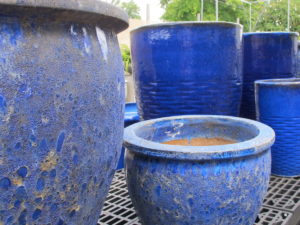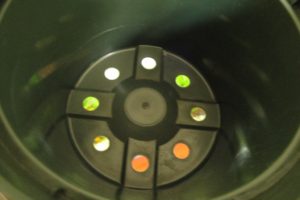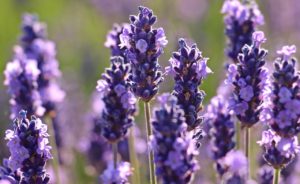Page 2

Water Tables and Rocks for Drainage
The Perched Water Table
It seems logical that soil would drain better when rocks are added to the bottom of the pot. But, to the contrary, rocks can slow down water trying to exit through the drainage holes. And it all has to do with those air pore spaces.
Gravel by itself has large air pore spaces between the pieces. So, water will pass through them after some of it adheres to the surface of the gravel. You’d think that potting soil on top of the gravel should drain freely. While water does drain freely close to the surface of the soil, percolation slows as the water approaches the bottom layer of gravel.
Gravity removes much of the excess water. At some point, though, water does not move readily from soil (with small air pore spaces) to the rocks (with large air pore spaces). The water sits at the bottom of the soil volume and hesitates moving into the rocks. This creates a “perched water table”, a layer of soggy soil above the rocks.
How Soil Drains in the Garden

Soil in the garden behaves differently. Gravity continuously pulls water down through the soil profile. Water percolates toward an aquifer, or it hits a layer of extremely compacted clay soil, called hardpan. When it hits the hardpan, water either pools there or slowly drains down the slope of the hardpan a foot or a few feet underground.
Much of the water, of course, will be used by plants, drain downslope, or evaporate to the atmosphere. The rest of the surface runoff drains toward roads, storm basins, or ditches, ultimately ending up in streams and other bodies of water.
Remember the Wet Sponge Experiment?
Soak a rectangular sponge in water until it’s saturated. Held horizontally, it contains the maximum amount of water the sponge can hold. Now, turn it upright, with the bottom edge horizontal. More water drips from the bottom of the sponge, right? The longer vertical axis of the sponge allows more water to drain as water passes from one part of the sponge to a lower part.
The air pore space is consistent throughout the sponge, so water is pulled through. You’ll notice that the bottom of the sponge is the wettest part. But eventually it will stop dripping. Now, hold the sponge on an angle, and the sponge will drip a bit more water from the corner to the air below.
At one point, the sponge will feel wet, but it won’t drip. As long as there’s material for water to drain to, you might be able to coax more water from the sponge. For example, if you hold a paper towel—even a wet one—to the bottom of the sponge, the paper towel will draw more water from the sponge because of gravity.
Air under the sponge—or gravel in the bottom of a pot—has large air pore spaces. Consequently, water won’t move from the sponge—or from the potting soil—into the air or into the gravel. Gravity can do only so much; after that, some kind of material with similar or smaller air pore space is needed to draw water through the soil. Then, when no more water can drain by gravity, capillarity will hold water in the sponge or in the perched water table.
The Water Table
We see that the flow of water is impeded at the interface between the soil and the rocks. A pot filled with only potting soil (no rocks for drainage) also holds water above the bottom of the pot. After excess water drains through the holes, that lowest region of soil will feel wet compared to the upper layer.
The difference between a pot with rocks for drainage and one without rocks is the soil volume occupied by the roots. A plant grows a more extensive root system in a pot without rocks, allowing larger and more vigorous top growth. A plant with a compromised root system, from soil that drains poorly, ordinarily will not grow as vigorously. In fact, it might get off to a difficult start due to the presence of constant moisture in the perched water table.
Conformation of nursery pots I’ve bought over the years consider these aspects of soil drainage. Here’s one where the bottom of the pot is molded higher in the center. This dome directs water toward and out the drainage holes. Bi-level drainage holes encourage air to circulate in the bottom of the pot (photo, below). Who would have suspected that this degree of science was involved in the design of the bottom of a simple plastic pot?!

A 6″ pot with a domed bottom for better drainage.
In Saturated Soil
Capillarity helps hold water among the soil particles until roots can absorb it. But, if the roots can’t use that water, they can rot if the excess can’t drain away. This water fills the air pore spaces, cutting off air circulation around the roots. Soon, anaerobic decomposition begins and contributes to root failure.

Lavender must have good drainage.
A full pot of thirsty annuals in hot sun or a large leafy tomato might be able to absorb all that water, but plants that need less moisture will suffer. Lavender, rosemary, succulents, orchids, and other plants requiring perfect drainage can be damaged in saturated soil. For these kinds of plants, keeping them potbound (not overpotting), using terra cotta pots, watering less often, and placing them under cover during rainy weather is advised.
In addition to those suggestions, add more plants to the container you want to use. More foliage dries the soil faster. Remove the mulch, at least until the young plants have grown. Before potting up, incorporate extra drainage material into the soil. This is especially important when using large pots.
Rocks for Drainage and Weight
I have used rocks for drainage on very few occasions. Businesses and schools hired me to fill concrete or ceramic planters. The extra weight of rocks prevented the pots from “walking away”. Amending the potting soil to facilitate drainage through the entire soil profile is the preferred method.
First, I covered the drainage holes with synthetic landscape fabric or a handful of polyester fiberfill. Then heavy rocks and gravel went into the bottom third of the large container. Instead of piling soil directly on top of the gravel, I added a layer of landscape fabric over the sloped surface of gravel and up the inside of the pot. Then I filled the space with soil.
Landscape fabric prevented soil from eroding into the gravel. Sloping the fabric, so water concentrated at a low point at the edge of the pot or in the center, helped remove more water from the soil, into the rocks, and out the drainage hole.
Sometimes I added rocks and/or charcoal for drainage when planting houseplants in decorative containers without drainage holes. Still, we should check for accumulating water and tip the planter on its side to let stagnant water drain out. Or use a dry wooden dowel to periodically test for moisture.
Otherwise, I never add rocks for drainage in a pot.
Headings
Page 1: Should We Add Rocks for Drainage?, Ingredients in Potting Soil (Materials Which Help Retain Water, “Sinking Soil Syndrome”, Reusing Potting Soil, Materials Which Increase Drainage), Air Pore Space and Gravity (Feel the Soil, Capillarity, A Simple Experiment)
Page 2: Water Tables and Rocks for Drainage (The Perched Water Table, How Soil Drains in the Garden, Remember the Wet Sponge Experiment?, The Water Table, In Saturated Soil, Rocks for Drainage and Weight)
Thanks! Soil drainage is one of those things we often neglect, but understanding how it works increases our expertise as gardeners.
Fascinating post!